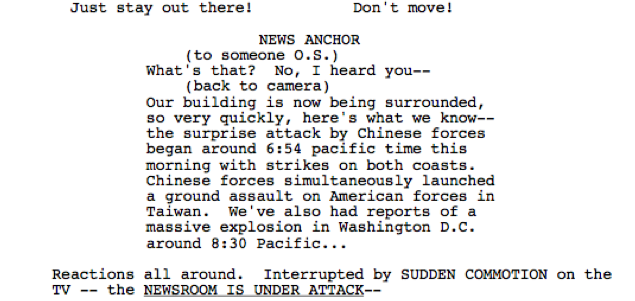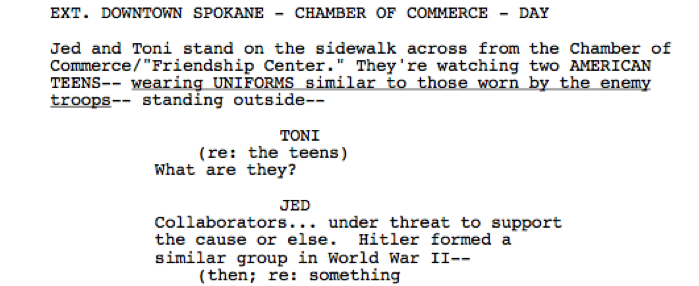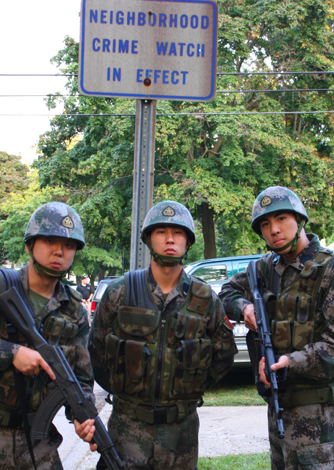Real America: "Red Dawn" Remade: China is Coming for Our Children
by Abe Sauer

Later this year, America’s dream factory will foist upon an already blooded-up America a remake of 1984’s Red Dawn. It’s probably the most unnecessary, irresponsible, Sinophobic film in America’s history, and that’s saying a lot. And it will be just in time for midterm elections already foul with the tea party’s red-white-and-blue jingoism. What a time for it-America’s relationship with China hasn’t been this crucial since, say, 1941.
The film is, indeed, just a film. Or as the MGM executive I spoke with described it: “just an action film.” Nonetheless, it is a bald example of how one-dimensionally America generally, at all levels, thinks about China and Chinese people.
And now, Red Dawn. Just the latest bit of escalation in the villainization of China, propaganda that’s sure to turn frothy in the next decade.

I obtained a copy of the script. In it, the Chinese invade and subjugate Americans to pinko commie rule all under the guise of “helping” the nation that has become too irresponsible to take care of itself. It is a paranoia tale of an America where our children no longer get stupid Chinese character tattoos because they want to; they get them because they have to. It’s basically porn for survivalist militia types who believe it is “real” scenarios like this that justify everything from the sale of assault rifles to electing nationalist fear-mongers.

Even worse, it’s just another in a long, tired, example of how America’s thinking about China has not progressed past Rohmer’s “Fu Manchu.”
When I contacted MGM, and expressed these concerns about the film, spokesman Grey Munford told me, “Red Dawn is an action film, it is not xenophobic and it is far too early in the process to make assumptions about the film that will appear in theatres.” He also told me the copy I had was stolen and a draft. (They declined to share a final copy or shooting script.)
That’s not the message the movie’s PR is putting out there though. Josh Hutcherson, who stars in the film, recently told MTV that “We’ve changed quite a bit of the story, but the heart of the story is there. The American, patriotic feel of the original, rising up against the invaders, is still definitely there. The Chinese are invading now, so we’re switching that up just to stay with the times a little bit.”
The film’s producer, Tripp Vinson, claims that “a lot of research” went into the China invasion scenario, including input from military “experts.” One of those experts was the RAND Corporation. RAND’s involvement may be the detail that most connects the remake to the original. Maybe no single organization went further and did more to architect and, more importantly, justify the anti-Communist military industrial complex and anti-Reds mindset that defined 20th-century America and that still in many ways defines America’s military structure. The Obama socialism/communism scare tactics the nation has seen recently all have their roots in the Cold War; RAND was the fertilizer for those roots. That, 20 years after the Cold War ended, RAND has its hand in a hawkish right-wing paranoid wank fantasy about China taking military action against the U.S. speaks to the persistent Red-Scare roots of an organization that still shapes policy (Iraq’s Ahmed Chalabi pooch-screw has its connections to RAND).

When I pointed out the remake to Jeff Yang, the “Asian Pop” columnist for the San Francisco Chronicle and a trendwatcher for Iconoculture, he was appalled. Of MGM’s “action film” reasoning, Yang said, “The notion that ‘action’ and ‘xenophobia’ are somehow contrasting principles is idiotic.” Then he told me what he really thought: “The action genre tends to be Manichaean — there’s good, evil, and little or nothing in between — and archetypal — characters are drawn big, iconic, and cartoony to eliminate anything that might distract from the mayhem. Your catharsis comes from rooting for the pure-hearted heroes and hating on the corrupt, inhuman villains. Unfortunately, the combination of these factors tends to turn action cinema into a cesspit of ultra-nationalism and, in the case of films where the villains are uniformly of another color, racism. It’s a short slide over from hating the evil Chinese villains in a film like this to subconsciously or consciously seeing all Chinese as evil villains, and hating them as well. The promotional campaign, which basically steals a page from the miniseries ‘V’ but with Chinese people rather than lizard aliens as the bearers of Trojan gifts, makes things even worse.”

America’s direct mistreatment of its own Asian (especially Chinese) populations is not so well known by Americans. While most are probably aware that our liberty-loving government interned over 100,000 Americans (who happened to have Japanese ancestry) during WWII, few are aware that the Chinese Exclusion Act was not repealed until 1943 (and even then Chinese immigration was effectively hobbled by low quotas). To this day the Aliens and Nationality section of the United States Code has only one entry specifically targeting a nationality; it is “Chinese.” Off the books and under the radar, there also continues a relentless unconscious drive to stereotype and dehumanize Asian populations both inside and outside the United States.
The must-read book on the subject of America’s dehumanization of its Pacific enemies, War Without Mercy, prophetically notes that even though “vicious racial stereotypes were transformed” after Vietnam, it “does not mean that they were dispelled. They remain latent, capable of being revived by both sides in times of crisis and tension.’’ In the 1980s that meant fear of Japan buying up America, which prompted the Foreign Ownership Disclosure Act and saw the oh-so-open-minded Gore Vidal warning of “the long-feared Asiatic colossus….” The New York Times Magazine ran a feature titled “The Danger From Japan.” Two laid-off Detroit auto workers got only probation and $3,000 fines after beating a Japanese-American to death with baseball bats. The original judge noted that the men were partially justified, as it was Japanese automakers that put them out of work. The dead man turned out to have Chinese heritage.
Next: The Beijing Olympics and the Media
By the late 1990s, Japan was an economic smoking crater. Today, to watch Sean Connery in Rising Sun is to have a good laugh. Our new Asian nemesis is China and starting with the Cox Report of 1999 (which accused China of using thousands of legitimate business in the U.S. as fronts for spying) and continuing through to Wen Ho Lee (the handling of which saw The New York Times finally, barely apologize), to the 2008 Olympics and beyond, America has turned to its old standby characterizations of Asians (this time the Chinese) as a faceless horde devoid of individualism, preparing to swarm. This is tragic.

The media’s anti-Asian bent is subtle and generally manifests itself in anti-China rhetoric. Last holiday season’s Zhu Zhu pets were reported to be toxic. Except on further testing, they weren’t. Yet the 120 seconds of national evening TV news the story got (about the same as the climate change conference) did not pass up the opportunity to say “made in China” over and over again. The New York Times printed a article describing certain bowls as having “Chinaman lids.” (The Times’ correction then recognized that Chinaman is “a term the paper considers disparaging” but that didn’t seem to stop it from getting printed to begin with.) When Obama met the Korean delegation to the UN, Jay Leno ran a “they all look the same bit.” Everyone laughed. 
Despite enjoying running Asians down, America does understand new economic realities; the other 1984 remake this year, Karate Kid, moves the location to China but keeps the Japanese martial art’s name. (Because if if they’re not the same thing, they all totally get along, right?) These small, day-by-day subtle racist slights are somewhat understandable coming from a culture that has nearly zero understanding its East Asian peers. For the 2008 Olympics, that subtly dispersed.
The Olympics saw Sinophobia explode and perfectly capture what War Without Mercy calls the stereotypical masculine “alien swarm” fear of Asians (as opposed to the feminine “exotic individual” one). In a Telegraph piece headlined “Beijing Olympics off to scary start,” Iain Martin wrote this of the Beijing opening ceremonies: “Thousands of people banging drums, dancing in a threatening and synchronised fashion, all the time shouting something that didn’t sound very friendly.” WaPo sports columnist Thomas Boswell made the long-awaited crossover into political op-ed in his review of the ceremonies, noting, “Watching the Bird’s Nest start to erupt was almost scary. The entire floor of National Stadium was filled with 2,008 drummers, all in silver robes trimmed in crimson. What did they portend?” Or as gasbag Bob Costas noted of the opening ceremony (between running down China for its connection to Sudan0, “It’s awe-inspiring. It’s also a little intimidating.”

Then there were the numerous inevitable, insufferable hacks who wrote about how the Beijing opening ceremonies were clearly comparable to those of 1936 Nazi Germany’s. This goes triply for Newsweek’s Olympic ceremonies liveblogger, who noted “The Chinese have resented any comparisons critics have made to the ’36 Berlin Games. Still, watching soldiers goosestep [sic] the Chinese flag feels a little eerie.”
The Olympics are over. So now the “Asian” carp are here, “invading” our Great Lakes in “swarms,” the only sized group in which Asians ever travel. The Washington Post from November, 2009: “’Asian carp are like cancer cells,’ said Cameron Davis, senior adviser with the U.S. Environmental Protection Agency. ‘They can grow and spread very, very quickly and overtake other healthy living organisms.’”

Not to leave out the states without lakes, the “Asian lady beetle” is “infesting” America: “…since 2003, the exotic Asian beetle has been on the attack” even though it is “smaller than a grain of rice.”
Of course, those really dead-set and determined to see China as a global threat to America should maybe not look to the gun or the gulag. The truest threat China poses to the United States is ideological. China’s success on its own terms could make hollow America’s promise of being the world’s best model for happiness. Nobody has summed that up better than China scholar, author and Asia Society expert Orville Schell. Schell, noting that China indeed has its problems and that it’s sure to have many more, nonetheless told NPR:
“…it raises a question that is sort of frightening to contemplate for an American, and that’s this: Does the Chinese system, this sort of autocratic form of capitalism, deliver better than democracy? And as an ardent democrat, I contemplate the answer to that question with some trepidation, because I think, you know, we feel in America, and in fact I think it’s more than a feeling, that in many ways our government is paralyzed, paralyzed by a lack of money, paralyzed in Congress, paralyzed by sort of vicious partisan politics, whereas China is able not only to gather information well but to form policy quickly and then, most importantly, to effect it. And you feel that everywhere you look in this country now, that they are on top of things, they’re able to do things swiftly to meet the very high-speed demands of the situation, whereas I think we are kind of languishing in many respects.”
Now, if red-white-and-blue-bleeding apple-pie-eaters really want to worry about China infiltrating the U.S., they should concentrate less on ammunition and more on erudition.
Next: Visiting an American High School’s Chinese Class.
Approximately 24,000 of about 54 million U.S. elementary and secondary school children are now studying Chinese. Yes, Chinese language instruction in American schools is “booming.” Of the 27,000-some middle and high schools in America offering a foreign language, the proportion offering Chinese “exploded” from 1 percent to 4 percent between 1997 and 2008. From The New York Times’ special report on Chinese language education: “Jackson High School outside Cleveland, OH has seen its Chinese program go from 20 students to 80 in just three years. Part of the reason the school could even offer the language was that it procured a free Chinese teacher. Not a teacher with free time, but a teacher who worked for free.”
As The Times notes, the teacher is actually not free but is paid for by an outreach program sponsored by China that places language teachers all over the United States. Minnesota, a state on the cutting edge of Chinese language education in America, operates a Confucius Institute out of the U of M that funnels money to grade and secondary schools looking to start Chinese language programs. A chunk of that institute’s funding comes from China’s Chinese Council on Language International (Hanban). Yes, China is paying for us to learn their language, hardly a roll-the-tanks-into-town and subjugate-the-masses scenario envisioned by the-coming-war wingnuts.
It’s not a threatening scenario at all. While there are many schools across the U.S. that want to begin teaching Chinese, it is often impossible to convince schools boards to approve funding. So, essentially, China is, in some cases, paying to educate our children because, as the richest nation on earth, we so often refuse to do so ourselves.
That doesn’t mean schools can start Chinese programs with ease. Natasha Pierce, a teacher who heads up Madison, Wisconsin’s Memorial High School Chinese studies program says that finding a Chinese speaker isn’t the problem: “There are a lot of native Chinese speakers-but a huge shortage of Chinese speakers who understand how to teach Chinese.” As Pierce points out, students do not learn much from a native speaker who has no teaching background.
Pierce recently let me visit her year three and year four Memorial High School Chinese class, which is Madison’s only.
In a classroom shared with the German program (ironic, as Chinese is now passing German to become the third-most tested AP language), I spoke with Pierce’s students about their perspectives on China. Beyond being shocked at their proficiency (the entirety of the class-hour was conducted in Chinese), it was moving and a testament to how much more these teens are learning than just the language. In fact, America’s future relationship with China may benefit exponentially from the cultural understanding these Chinese language students are taking with them.
“China’s going to be the next superpower,” said one student, after which everyone laughed, loudly. But he’s not joking and the rest of this class understands this.
One wants to major in business and thinks it will help her in the future. Another, wise beyond her years, said, “I take it not only for the language and the culture but because of the number of people you can communicate with in Chinese. I also take Spanish. Taking those together that allows me to speak with billions of people.”
Another student said, “It’s dumb to blame people in China. I’m sure they’re people in China who disagree with what’s going on with their government.”

Some in the class left me with longer thoughts on our nation’s (or at least their personal) future relationship with China. These thoughts follow unedited and are wildly encouraging, as they are held by 16- and 17-year-olds:
• “In the coming years I hope to see the relationship between China and America improve. I don’t think it can, however, unless we strive to have our younger generations learn about each other’s culture. If we begin learning something foreign earlier in life, such as culture or language, it is easier to assimilate into our own way of life. I think simply growing up to have a better respect and regard for each other would greatly improve the political relations of future generations.”
• “China will be at least a full equal of the US. It will happen, it cannot be avoided, and we must prepare for it, instead of wasting time and effort trying to stop it. A US attempt to stop China’s rise would only increase motivation and efforts to surpass the US in all areas. A welcoming approach leaves the best chance of future equality.”
• “I believe that in my future China and the US will continue to be wary of each other, but at the same time, will (I hope!) work together more closely. I do not believe that these two world powers will ever be as close as, say, America and England, because of the preconceptions the citizens of both countries have of the other. However, I think it would be unwise for the two countries to turn against each other, because China could make a formidable enemy to the US, and of course vice versa.”
• “In the future, I see China as becoming an economic ‘superpower’ and I think that there will be a lot more job opportunities concerning the US and China (think business) and knowing Chinese will be incredibly useful in the future. Instead of most people learning Spanish as their second language, most people will be learning Chinese as their second language in the future. I would suggest that the future generations of Americans learn Chinese as a second language.”
• “I think that government officials need to have a deeper understanding of the culture of the other country, especially when it comes down to making foreign policy decisions. I feel that often conflict arises between two nations due to culture-based misunderstandings. I have found that in my studying of Chinese language and culture, I have come to understand the influence one’s culture has on their actions while some would otherwise make generalizations.”
Red Dawn and RAND attitudes are not the only hindrances these students face. As The New York Times “Room for Debate” blog demonstrated, there is a lack of optimism even amongst proponents of education, and certainly less amongst the general population, for Chinese language programs. There are utilitarian roadblocks aplenty, from the fact that the Chinese already learn English (so why bother), to the idea that it’s just a fad, like Japanese, (so why bother). Learn Chinese or learn math and science seems to be the choice offered, as though the ability to do both is impossible.
It is not realistic to expect U.S. schools to begin turning out fluent Chinese speakers. In linguistic terms, Chinese may be easier to learn than Spanish or French; but in practical ways, it is much, much more difficult. But UN-translator-level pronunciation and vocabulary should not the only goals of such programs. It is valuable to breed cross-cultural understanding. It’s valuable to create a generation that regards China as neither a Shangri-La of dragons, mysticism and sideways vaginas nor as a red menace poised to invade the U.S. with its billions-strong horde army of indistinguishable and interchangeable multitudes. American educators, and parents that care about how their children will live in a post-U!S!A! world, have a unique opportunity right now to expose children to more than just a language; they have a window to craft a future with a better chance of peaceful coexistence, a world where Red Dawn remains a fictional remake trotted out by manipulative profiteers every 20 years to sucker reactionary fools who, by refusing to see the future, have always been dragged kicking and screaming by the rest into a more progressive era.
In a Red Dawn world, our high school students must be armed to kill the Chinese. Arm them with some Chinese and maybe they won’t have to… or want to.
Abe Sauer won’t be hitting this one in the theaters.
